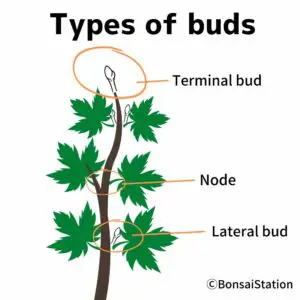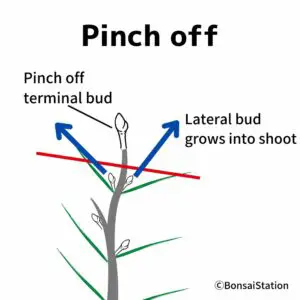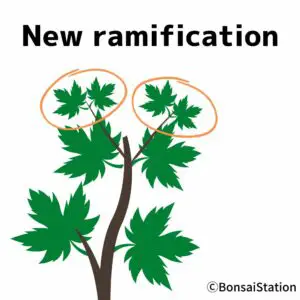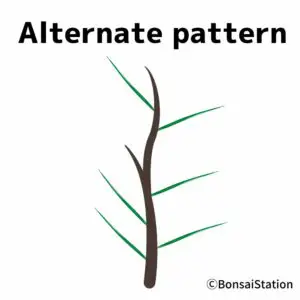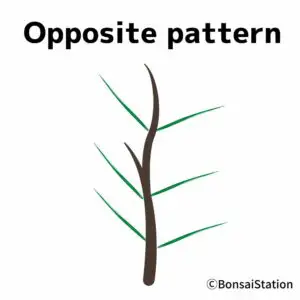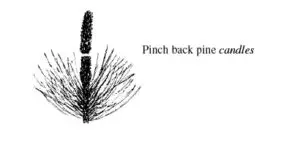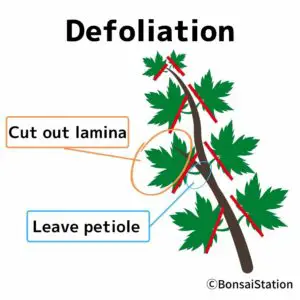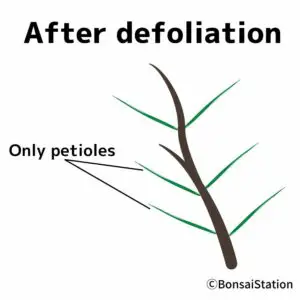Pinching
Pinching (tipping) is one of the two pruning methods used on bonsai trees to encourage ramification.
How pinching out works to increase ramifications
What is apical dominance
Pinching out the tip of the branches uses plants’ growth characteristics to make bonsai trees bushier. For many plants, including bonsai trees, only one growing point exists: the tip of the stems or “terminal bud”.
As the stem elongates at the terminal bud, nodes (areas where a leaf is attached) and lateral buds are formed.
Although one to three lateral buds are produced at each of the nodes, terminal buds inhibit the growth and development of lateral buds by producing a plant hormone so that the trees’ energy is directed towards one point, rather than being distributed among lateral buds.
The plant hormone produced by the terminal buds puts lateral buds in a dormant state until the time comes for them to grow. It varies from one tree species to another. Some trees suppress the growth of their lateral buds until the next growing season; others develop both lateral shoots and terminal buds during the first growing season.
This phenomenon that only terminal bud has the power to grow is called apical dominance and is seen in bonsai species such as Japanese cedar, pine, spruce, Japanese maple and oak. While this is a more common phenomenon, other tree species such as Satsuki azalea do not have this characteristic.
How pinching terminal buds works
Removing the terminal buds temporarily impairs apical dominance; meaning the growth at the tip of the branches stops. It awakens dormant lateral buds and stimulates them to grow into shoots. These new shoots become new branches.
By pinching off terminal buds several times a year, branches ramify 3 to 4 times that would otherwise only ramify once (or maybe twice) a year.
How to pinch out a bonsai tree
Deciduous/flowering/fruiting trees
When branches grow and have 2 to 3 nodes, pinch out the terminal buds, leaving 1 to 2 nodes. Whether to leave 1 or 2 nodes depends on the growth pattern of branches, alternate or opposite.
With the alternate pattern, leaves are produced one at a time, with one leaf at each
node. With the opposite pattern, leaves are produced two at each node, on opposite sides of the branch.
For trees with the alternate pattern, leave 2 nodes. For those with the opposite pattern, leave 1 node. As lateral buds grow alongside leaves, pinching out enables two shoots to grow instead of one if left to grow naturally.
Bonsai tree species with alternate and opposite patterns
| Alternate pattern | Opposite pattern |
| Birch Cherry Elm Oak Pine |
Apple Japanese maple Pomegranate |
Coniferous trees
Pinch out the new shoots by half when they have come out while the new leaves have not yet opened. The new shoots look like candles covered with hair-like scales. Vigorous and big shoots can be pinched back nearly at the base. Small shoots with poor growth, on the other hand, should be left unpinched.
(Source: Virginia State University)
If several shoots are coming out in one place, remove the smaller shoots from the base and leave a couple of shoots that look good for new branching.
In about 2 weeks, 1 to 3 new shoots will appear around the shoots that are pinched.
Defoliating
Defoliation as a bonsai technique is done for several reasons and encouraging ramification is one of them.
How defoliating works to increase ramifications
What is defoliation?
Defoliation is a process of losing leaves. It can happen naturally as a part of plants’ growth cycle or can be caused by environmental factors such as extreme weather conditions or pests.
Defoliation can be artificially done as well. In bonsai, we sometimes cut off part or all of the new leaves that have grown in spring, leaving the tree bare, and allowing new leaves to sprout again.
How does defoliation work to increase the number of branches?
When all (or part of) the leaves are cut off during the growing season, it stimulates vigorous resprouts from dormant lateral buds on the main stem and lateral branches.
This is a part of plants’ defense mechanism to survive. They need leaves to create energy through photosynthesis and they need to regrow leaves rather quickly before they used up all the energy they stored before losing leaves.
Defoliated trees often redirect resource allocation from growing branches to new leaves to the point that the foliage is usually denser than before. This overcompensation is an important recovery strategy in woody plants such as bonsai trees.
Defoliation also allows sunlight to come inside the foliage into the buds, stimulating them to grow. Several environmental factors control the activity-dormancy cycle of buds and shoot growth but the light is a major factor that significantly impacts new branching.
This is why numerous new shoots and thus branches emerge after defoliation.
How to defoliate a bonsai tree
Total defoliation
-
- Observe and check bonsai tree(s) well to see if they can be defoliated. If they look weak, sick, infested by insects, or their leaves are not fully open yet, do not defoliate at all.
- Place the bonsai pot on the table. Cut out lamina (leaf blades), leaving only the petioles one by one using bonsai scissors/sheers. Start from the top of the tree, and gradually move down.
- Use a small broom to sweep the leaves that are cut from the tree.
- After removing leaves, water it thoroughly and put it on a shelf outdoors and exposed it to sufficient sunlight until it sprouts.
For detailed information on how to defoliate a bonsai tree, please check the following post.


